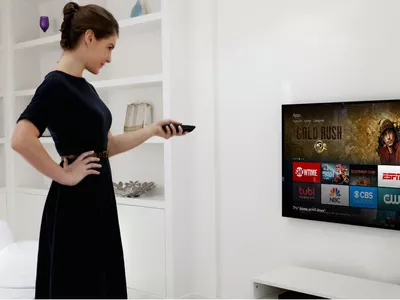
In 2024, How To Fix Auto Lock Greyed Out on iPhone 11

How To Fix Auto Lock Greyed Out on Apple iPhone 11
Auto-lock on iOS devices serves multiple purposes - it conserves battery life, secures your data, and more. But have you encountered the Auto-Lock greyed-out dilemma, fixed at 30 seconds? When this setting becomes inaccessible, it limits your control over screen timeout.
Read on if you’ve encountered a similar problem on your iOS device. In this guide, we’ll explore the possible reasons and offer steps to fix Auto-Lock greyed out on iPhone and iPad devices. If force restarts or settings resets haven’t worked for you, we’ve got alternative solutions. Let’s get started.

Part 1: Why Is Auto-Lock Greyed Out on iOS Device?
There are a few reasons why the Auto-Lock might be greyed out on your Apple iPhone 11 or iPad device, preventing you from adjusting the duration. Here are the most common culprits:
Low Power Mode
When you activate Low Power Mode on your iOS device, you might notice the screen automatically locking after 30 seconds of inactivity. This quick sleep setting, implemented to minimize power usage, explains why the Auto-Lock option appears greyed out and inaccessible.
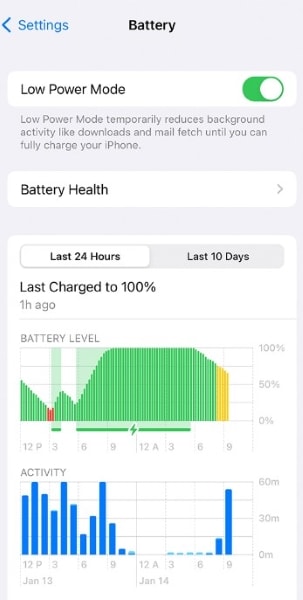
Screen Time Restrictions
Screen Time restrictions can impact Auto-Lock. For instance, if your downtime schedule blocks all apps, the screen locks itself, even if the Auto-Lock timer hasn’t run out.

MDM Profile Restrictions
If the Auto-Lock is greyed out on your iPad or iPhone and you use it for work or school, a Mobile Device Management (MDM) profile might be the reason. This profile restricts settings, including Auto-Lock. To fix this, contact your IT administrator and ask if they can adjust the MDM profile settings.
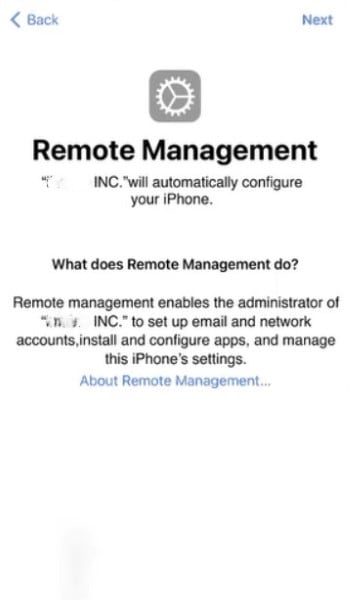
Alright, you know the possible reasons why the Auto-Lock option is not working on your iOS device. Still, you might be wondering how to fix the Auto-Lock greyed-out issue. Below are several ways to get your iPad or iPhone Auto-Lock working normally again.
Fix No.1: Disable Low Power Mode
Your iPhone Auto-Lock greyed out because Low Power Mode limits background activities, including the Auto-Lock option. In this mode, you cannot change the Auto-Lock settings. Turn off Low Power Mode to fix this issue and choose your preferred timeout. Here’s how:
- Step 1: Go to your Apple iPhone 11 or iPad’s Settings app.
- Step 2: Scroll down and tap Battery. It will show you your device’s battery usage and available settings.
- Step 3: Turn off the Low Power Mode. Now, the greyed-out Auto-Lock option in Settings should be available again.

Low Battery Mode can stretch your battery life further. But if you need your screen to stay on longer, like while reading an article or watching a video, you can turn it off. It lets you adjust the screen timeout in Settings so it stays awake for as long as you like.
Fix No.2: Check Screen Time Restrictions
You’ve ruled out the Low Power Mode, but the Auto-Lock greyed out on iPad or iPhone remains. If Low Power Mode isn’t causing the problem, your screen time settings might be the issue. Some app restrictions can limit your screen use to specific times, causing it to lock automatically. Resolve this by removing limits, such as downtime and app restrictions, or turning it off.
- Step 1: Open the Settings app on your iOS device.
- Step 2: Go to Screen Time, then scroll down.
- Step 3: Tap Turn Off Screen Time.

Fix No.3: Remove MDM Configuration Profile
A configuration profile is a file that contains settings and restrictions that can be applied to an iOS device. Organizations, schools, or IT administrators often use it to manage devices remotely and enforce specific configurations. Once installed, the settings within a profile override the Apple iPhone 11 device’s default settings. It can include restrictions related to security, network access, app usage, and more.
Since an MDM configuration profile causes limitations, like the greyed-out Auto-Lock on iPad, removing it can be the solution. Doing so frees your iOS device from external settings imposed by the profile. Then, it could allow you to adjust the Auto-Lock time setting as you normally would.
Step 1: See the configuration profiles you installed on your iOS device.
Go to Settings> General > VPN & Device Management on your Apple iPhone 11.
Go to Settings> General > Profiles & Device Management on your iPad.
Step 2: Select the configuration profile you need to delete.
Step 3: Tap Remove Profile, enter your device passcode, then tap Remove.

Fix No.4: Remove Network Settings Installed by MDM
Businesses often use Mobile Device Management (MDM) to remotely manage their employees’ iPhones and iPads. MDM lets IT admins push software updates, restrict apps, and remotely wipe a lost device. This keeps corporate data safe and devices under control, whether the company or the employee owns them.
If you’re having trouble with a greyed-out Auto-Lock timeout setting, disassociating your device from MDM might be an option. But remember, this is a big step. Make sure you follow your company’s authorized procedures to avoid unintended consequences.
If your IT team gives the green light, you might also be able to remove the network settings installed by MDM. Just proceed with caution, as messing with these settings could lead to instability or data loss. Here’s how:
- Step 1: Open the Settings app on your iOS device.
- Step 2: Navigate to General > Profile or VPN & Device Management (or a similar section).
- Step 3: Select the management and tap Remove Management.

If the option is unavailable, only the person who used Apple Configurator 2 or handles your company’s mobile device management platform can remove it.
Fix No.5: Use Dr.Fone To Bypass MDM Lock Without Data Loss
Unfortunately, manually removing profiles can be tricky, especially if they’re associated with MDM, Apple School Manager, or supervised configurations. These often require the removal of passwords, admin privileges, or complete data wipes. But there’s good news. Wondershare Dr.Fone - Screen Unlock (iOS) provides a simpler and safer solution.
Here’s why you should try it:
- **Speedy and Efficient:**No more endless troubleshooting. Dr.Fone bypasses the MDM lock in minutes, saving you precious time.
- **Data Stays Safe:**Unlike factory resets, Dr.Fone keeps all your precious photos, messages, and apps right where they belong.
- **No Jailbreaking:**Say goodbye to complex hacks and warranty voiding. Dr.Fone works without jailbreaking your Apple iPhone 11, keeping it healthy and secure.
- **Universal Compatibility:**Whether you own the latest iPhone with iOS 17 or an older version, Dr.Fone has your back. It supports all iOS devices and versions starting from iOS 7.0.
Have you ever bought a used iPad or Apple iPhone 11 to find the Auto-Lock option greyed out and isn’t working? Mobile Device Management (MDM) profiles, often deployed by companies or schools, can restrict functionality. If you lack the credentials to bypass or remove it, Dr.Fone can help remove all MDM restrictions on your iOS device. Here’s how:
- Step 1: Download and open Dr.Fone on your computer. Next, connect your Apple iPhone 11 or iPad to the computer using a USB cable and navigate to Toolbox > Screen Unlock > iOS.

Tips: Are you searching for a powerful Screen Unlock tool? No worries as Dr.Fone is here to help you. Download it and start a seamless unlock experience!
- Step 2: Within the Screen Unlock tool window, select Unlock MDM iPhone.

- Step 3: Select Bypass MDM, then click Get Start to proceed.
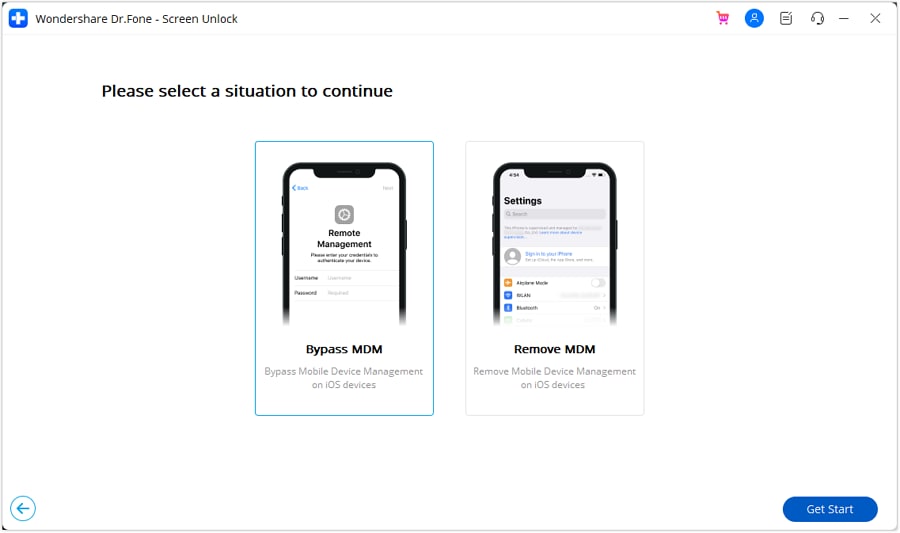
- Step 4: Please review the message carefully before initiating the MDM bypass process. Once you’ve read it, click Start to Bypass to proceed.
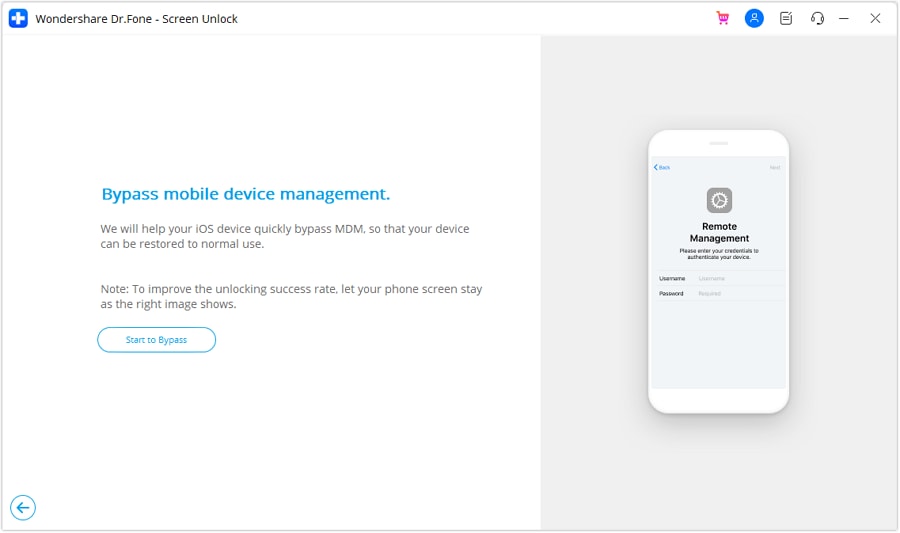
- Step 5: If prompted, go to your device’s Settings > Apple ID > iCloud and turn off the Find My feature. Next, click OK to initiate the MDM bypass.
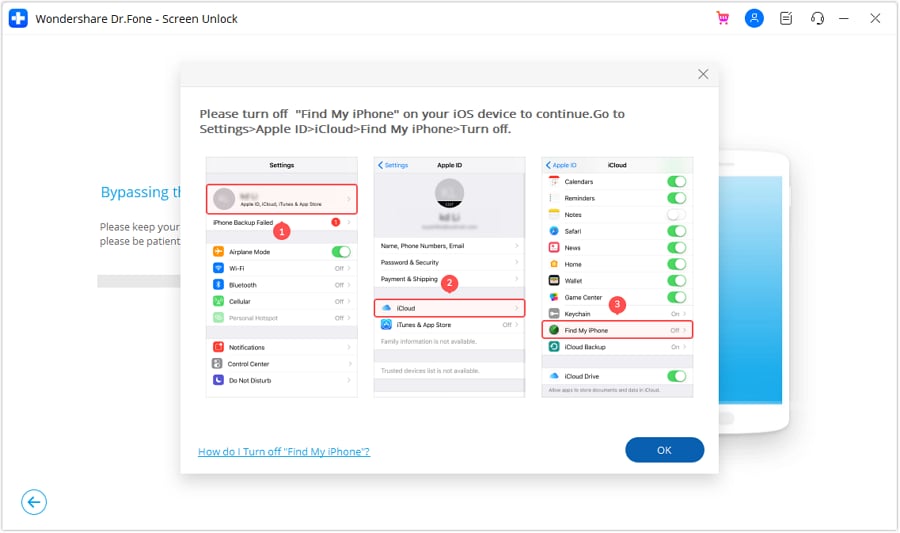
- Step 6: The software will display the progress of the bypass. Wait for it to complete.
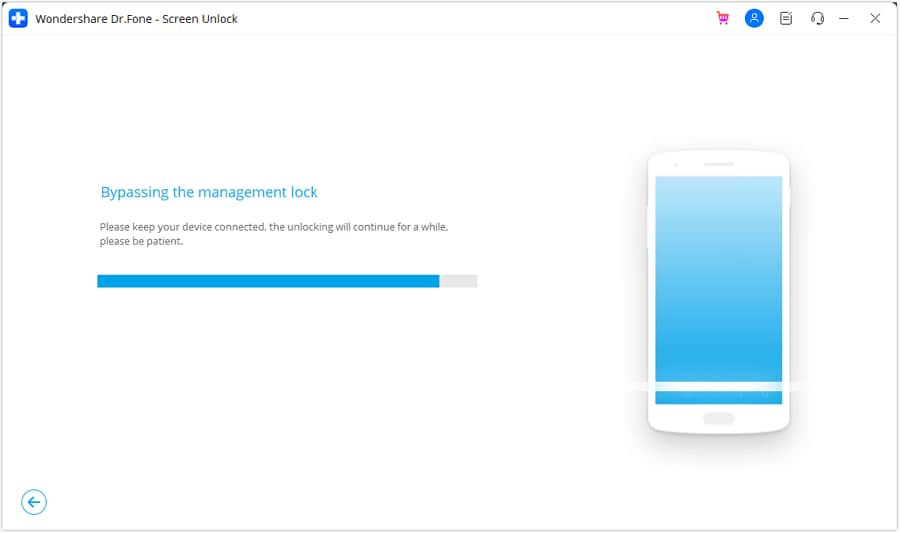
- Step 7: You’ll see a confirmation message once the bypass is successful. Click Done to exit. Your device should now be free from MDM restrictions.

Fix No.6: Check and Adjust Auto-Lock Settings
Once you’ve tried all the fixes above, you might need to set up the Auto-Lock timeout again.
- Setup Auto-Lock on iPad
Here are the steps on how to change Auto-Lock on iPad devices:
- Step 1: Within the Settings app, scroll down the list on the left-hand side and tap Display & Brightness.
- Step 2: On the right-hand side of the Display & Brightness screen, tap the Auto-Lock option.

- Step 3: A list of time options will appear, ranging from 2 minutes to 15 minutes, as well as Never. Select the time you want your iPad to wait before automatically locking the screen after inactivity. If you want the screen to stay on indefinitely, choose Never.

Step 4: Once you’ve selected your preferred auto-lock duration, you can exit the Settings app. The change will be applied automatically.
- Setup Auto-Lock on iPhone
Here’s how to change Auto-Lock on iPhone devices:
- Step 1: Open the Settings app.
- Step 2: Tap on Display & Brightness, scroll down, and tap Auto-Lock.
- Step 3: Choose the desired time interval for your Apple iPhone 11 to automatically lock. The available options typically range from 30 seconds to 5 minutes. You may also have the option to select Never if you prefer to have the screen stay on indefinitely until you manually lock it.

Conclusion
There you have it. This guide has equipped you with the knowledge and solutions to fix the Auto-Lock greyed out on your Apple iPhone 11 or iPad devices. From identifying the reasons like Low Power Mode and MDM configurations to implementing actionable fixes, you can now change your screen timeout. So, turn off those restrictions, remove MDM profiles, and head back to Settings.
For an easy solution, use Dr.Fone Screen Unlock to bypass MDM restrictions, giving you control over your device. Whether it’s a work phone or a personal device under MDM, Dr.Fone can offer an efficient solution. With a few clicks, you’ll have the Auto-Lock back on track, ensuring your iOS device works again just how you want it.
Tips: Are you searching for a powerful Screen Unlock tool? No worries as Dr.Fone is here to help you. Download it and start a seamless unlock experience!
How to Fix Apple iPhone 11 Passcode not Working?
Apple has always been one of the top successful companies. The reason for its success can be clearly seen through its efforts in pioneering top-notch products. It not only puts its efforts into ensuring the perfect working of the Apple iPhone 11 device but also provides the user with essential security measures to protect the data of the Apple iPhone 11 device from unauthorized access.
This is the sole reason why Apple focuses so much on privacy through passcodes. But sometimes, these passcodes can be a hurdle in the working of the iPhone.
If you’re facing this issue, then you’ve come to the right place. This article shall cover your queries regarding fixing the Apple iPhone 11 passcode that is not working and providing full-depth details for your ease.
Part 1: Why iPhone is Saying Passcode is Wrong?
If you enter the wrong password, your Apple iPhone 11 will not accept it and won’t open your phone. If you repeatedly enter the wrong password, it will disable your phone mainly because of security reasons. However, sometimes you’re genuinely trying to enter the correct password, but your device won’t accept it. This isn’t common, but there are quite a few reasons why iPhone is saying your passcode is wrong.
Sometimes the problem is trivial, like you may have entered the wrong keys in a hurry, due to which it won’t accept your passcode. In other cases, face recognition may not recognize your face if you’re wearing any mask.
However, occasionally the problem is technical. Sometimes, your Apple iPhone 11 may be corrupted. This can cause trouble for your device to detect the security file where your passcode is stored. Other times, the operating system may not be installed properly after updating to the new version of iOS.
Part 2: Remove iPhone Passcode with Dr.Fone Without Losing Data
Everyone in the field of tech is familiar with Wondershare as it is the most innovative and versatile software in the market. Dr.Fone is a toolkit containing data recovery, phone manager software, etc., introduced by Wondershare. One of the many reasons for its success is the intuitive interface that has made it convenient for professionals as well as amateurs.
When it comes to fixing your Apple iPhone 11 passcode, which is not working, Wondershare Dr.Fone - Screen Unlock does wonders.
iTunes is another great way to bypass the activation screen without a SIM card. If you’re new to this, here’s a small guide on how to use iTunes to bypass the activation screen.
Dr.Fone - Screen Unlock (iOS)
Remove iPhone Passcode.
- If you don’t have access to iTunes, Dr.Fone is a great alternative.
- Compatible with all models of iPhone and other iOS devices.
- It resets the factory settings without requiring the passcode.
- It recovers data after resetting iPhone’s passcode.
3981454 people have downloaded it
Step 1: Connect Apple iPhone 11 to your Computer
The first step is to connect your Apple iPhone 11 to your computer via cable and install Wondershare Dr.Fone - Screen Unlock.

Step 2: Screen Unlock Tool
Select the “Screen Unlock” tool from the given tools on the home interface. Another interface will be displayed on the screen in which you’ve to select “Unlock iOS Screen.”

Step 3: DFU Mode
Before directly unlocking the Apple iPhone 11 lock screen, you’ve to set it up in either Recovery mode or DFU mode. Mostly ‘Recovery Mode’ is recommended as it removes the passcode by default. However, if your device fails to activate it, you can opt for DFU mode.

Step 4: Download Firmware
Once your Apple iPhone 11 is in DFU mode, another window will be displayed on the screen, asking for confirmation regarding the Apple iPhone 11 device Model and System Version. Now click on the “Download” button placed at the bottom.

Step 5: Unlock your Apple iPhone 11.
After downloading the firmware, select “Unlock Now” to unlock your Apple iPhone 11.

Part 3: Effective Ways to Fix iPhone Password Not Working
This part shall assert its focus on the effective ways of resolving the issue involving the Apple iPhone 11 password not working on your device. It revolves around the methods involving iTunes, iCloud, and iPhone Recovery Mode.
3.1 By using iTunes and iPhone Cables
iTunes is one of the most used and innovational software pioneered by Apple. It has proved to be the best software out there through its versatility and exceptional performance. This software is your savior if you’re looking for something to organize your files in iPhone as it has great integration with iOS.
If you want to fix your Apple iPhone 11 passcode, which is not working, then iTunes can be an efficacious solution for your problem. Below we have explained step-by-step how to fix your passcode in iPhone using iTunes:
Step 1: Connect to Computer
The first step is to connect your Apple iPhone 11 to the computer with which you’ve synced previously.
Step 2: Recovery Mode and Synchronize
Now open iTunes. If it asks for a passcode, try another computer that you’ve synced your device with. Else, put your phone to Recovery mode. Wait for iTunes to detect and sync your device. It will then create a backup.
Step 4: Restore
Once your device is synced with iTunes, a “Set Up” window will pop up on the screen displaying two options, “Restore” or “Update.” Select “Restore” to proceed further.
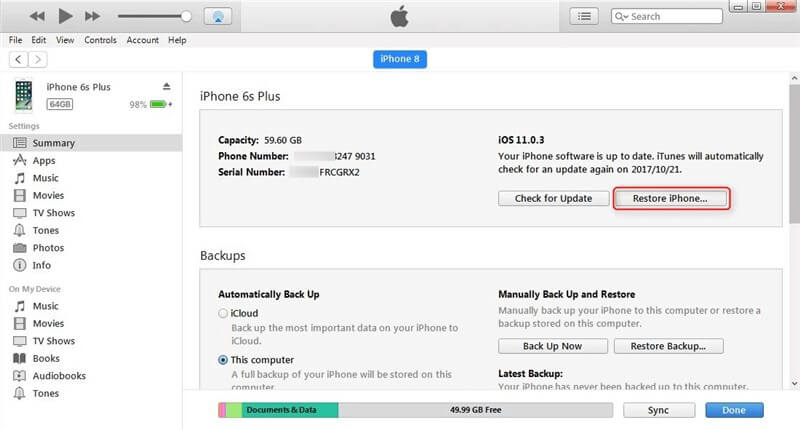
Step 5: Reset Passcode
Select your device and the appropriate backup for your device in iTunes. Once the process is completed, you can reset the passcode of your Apple iPhone 11 in the settings.
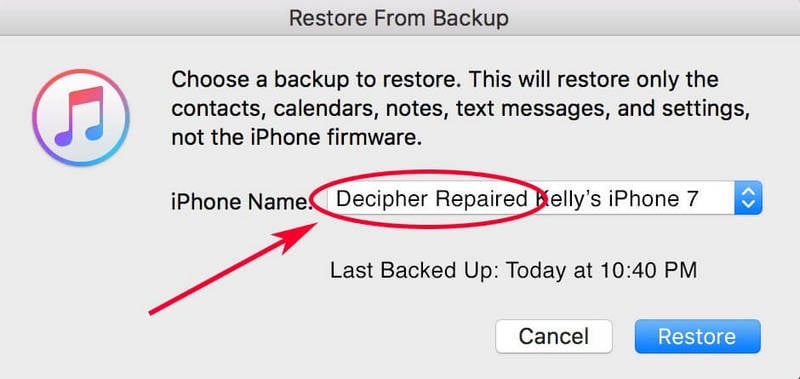
3.2 Apple iCloud Feature
iCloud is a multifunctional drive compatible with iOS and macOS. It saves your data, your media and organizes your files in folders. Moreover, it allows the user to share media, data, files, and even location with the other iPhone/iOS user. The major feature of Apple iCloud is its ‘Backup’ which stores all your data in case you lose or damage your phone.
To fix the Apple iPhone 11 passcode, which is not working, iCloud can come in handy. But this method can only work if you’ve logged in to your iCloud account on your Apple iPhone 11 and your “Find My iPhone” application is turned on. All you have to do is erase your data which will automatically erase your passcode through iCloud.
Step 1: Sign in with Apple ID
First, open iCloud.com on another iOS and write your credentials to sign in your Apple ID.
Step 2: Select your Device
Click on “Find My iPhone” and select “All devices,” and a list of devices will come up which are working under the same Apple ID. Select your Apple iPhone 11.
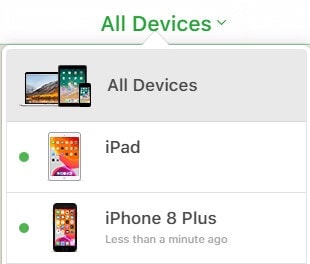
Step 3: Erase Data and Set up your Apple iPhone 11.
Now click on the option of “Erase iPhone” to erase all your data and even your passcode. You have the autonomy to set up your Apple iPhone 11 from a previous backup or set it up as a new device.
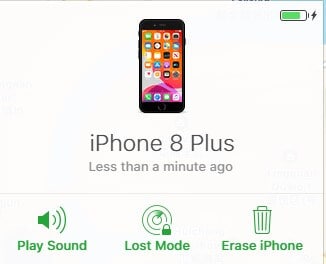
3.3 Using iPhone Recovery Mode
If you’ve never synced your Apple iPhone 11 with iTunes or set up “Find my iPhone” and you’re out of options, then iPhone Recovery Mode can come to the rescue. Recovery Mode allows your Apple iPhone 11 to connect with iTunes without restarting the system.
This process is quite time-consuming and different for different versions of the iPhone. Here we will guide you on how to fix the Apple iPhone 11 passcode via Recovery Mode.
Step 1: Connect your device to the Computer
Connect your Apple iPhone 11 to your computer and open iTunes.
Step 2: Activate Recovery Mode
Once the computer detects your Apple iPhone 11, it force restarts it. Activating Recovery Mode is different for different models of iPhone.
- For iPhone 6s and earlier versions: Press and hold the Home Button and the Power Button simultaneously.
- For iPhone 7 and 7 Plus: Press and hold the Power Button and Volume Down Button simultaneously.
- For iPhone 8 and latest versions: Press and release the Volume Down button instantly. Then again, press and release the Volume up button. Now press the Power Button till you see the option of “Recovery Mode.”
Step 3: Restore your Apple iPhone 11.
When you’re given the option of Restore or Update, choose ‘Restore.’ iTunes will automatically download the appropriate software.

Step 4: Set Up your Apple iPhone 11
Once the process has reached completion, set up your Apple iPhone 11, if this process takes more than 15 minutes, it will leave the Recovery Mode automatically and repeat the steps again.
Conclusion
This article has provided you the reasons and best possible ways to fix the issue of the Apple iPhone 11 passcode not working in detail. You must follow these steps immediately if you’ve locked your Apple iPhone 11 to avoid further trouble and anxiety.
We hope we have covered every bit of this article perfectly and you have successfully unlocked your Apple iPhone 11 without any hassle.
Apple iPhone 11 Asking for Passcode after iOS 17/14 Update, What to Do?
If you’ve recently updated your iOS iPhone and iPad to the iOS 17/14 operating system, you may notice a bit of a bug where the Apple iPhone 11 displays the passcode lock, even if you haven’t got a security code in place.
This obviously means you won’t be able to access your phone, and in many cases, you’re going to want to get back into your phone as quickly as possible. However, this may be easier said than done. Fortunately, today we’re going to go through multiple solutions to help you get your device working as it should!
Part 1. Don’t try passcodes blindly
One of the worst things you can do when faced with this situation is to enter passcodes blindly. Perhaps you’re trying random numbers and letters, or you’re trying passwords you’ve used in the past. If you get it wrong, you’re going to be locked out of your device for a long time.
The more times you get your code wrong, the longer you’ll be locked out, so avoid doing this at all costs, so make sure you move straight onto these approaches to get your phone working as quickly as possible.
Part 2. 5 ways to unlock iPhone after iOS 17/14 Update
2.1 Try a default passcode in your family
While we said, you shouldn’t type in random numbers to try and guess the password, of course, if you have a standard family passcode that you use across all iOS devices, perhaps an admin password or just something you use for everything, it can be well worth a try.
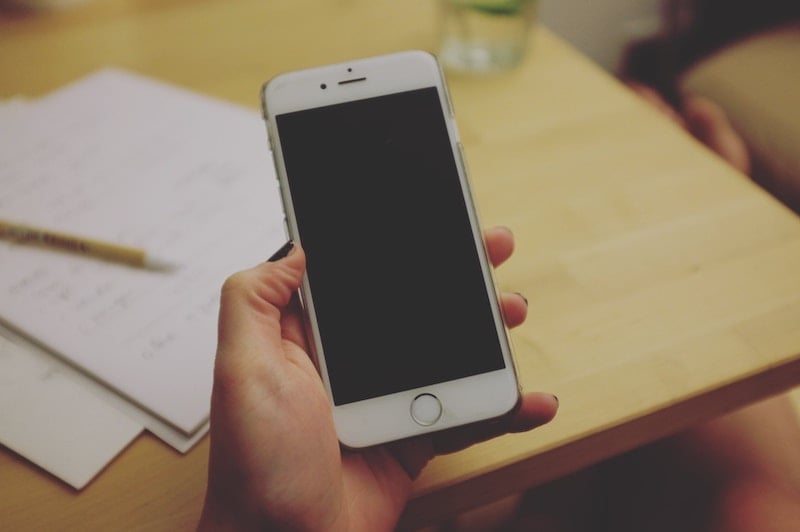
In reality, you get three attempts to put a passcode in before it locks you out, so try two passcodes that your family uses to see whether this will easily unlock your device. If you brought your device preowned and still have contact with the owner, they may have a passcode you can try.
2.2 Unlock iPhone with an unlock tool
The second approach you can take if you don’t know the passcode and can’t get it unlocked is to use a powerful software solution known as Dr.Fone - Screen Unlock (iOS) . This Wondershare software application completely unlocks your phone, even if you don’t know the passcode.
This software is easy to use and incredibly simple, yet it gets the job done. If you’re looking for a quick way to get your iOS device back up and running with full access after an iOS 17/14 update, it doesn’t get much better than this. Here’s how it works;
Step 1. Download and install the Dr.Fone - Screen Unlock (iOS) software to either your Mac or Windows PC and open it, so you’re on the homepage. Connect your iOS device to your computer using the USB cable and wait for the software to recognize your device.
When it does, close iTunes if it automatically opens and clicks the Screen Unlock option from the main menu.

Step 2. Click the Unlock iOS Screen option.

Step 3. You will now need to put your device in DFU mode, also known as Recovery Mode. Fortunately, this is easy thanks to the on-screen instructions where you will hold down the volume down and power button for a few seconds.

Step 4. Once Dr.Fone - Screen Unlock (iOS) has detected your device in DFU Mode. You’ll be able to select which device you’re using and what firmware you want to be repaired; in this case, iOS 17/14.

Step 5. Once everything has been confirmed and you’re happy to continue, press the Unlock option. The program will do its thing, and when it’s done, the software will say you’re able to disconnect your Apple iPhone 11 and use it without a lock screen!
That’s how easy Dr.Fone - Screen Unlock (iOS) makes the entire unlock process!

2.3 Restore an old backup from iTunes
Another key way that some users have found to unlock their device after an update is to restore their device to an older version, aiming to put your device back into a position where it didn’t have a lock screen.
It’s only possible to do this if you’ve backed up your iOS device in the past (which is why you’re encouraged to back up regularly), and it can all be done through the iTunes software on either your Mac or Windows computer. Here’s how it works;
Step 1. Ensure you’re running the latest version of iTunes and then connect your iOS device to your Mac or Windows computer using the official USB cable. This should automatically open the iTunes window.
Step 2. In iTunes, click the symbol representing your device and then click Summary. On this screen, you’ll be able to choose the Restore iPhone option at the top to begin the restoring process.
Step 3. Follow the onscreen instructions where you’ll choose which backup file you want to use before iTunes, then restores your device. When the software has completed the process, you’ll be able to disconnect your Apple iPhone 11 and use it without a lock screen!
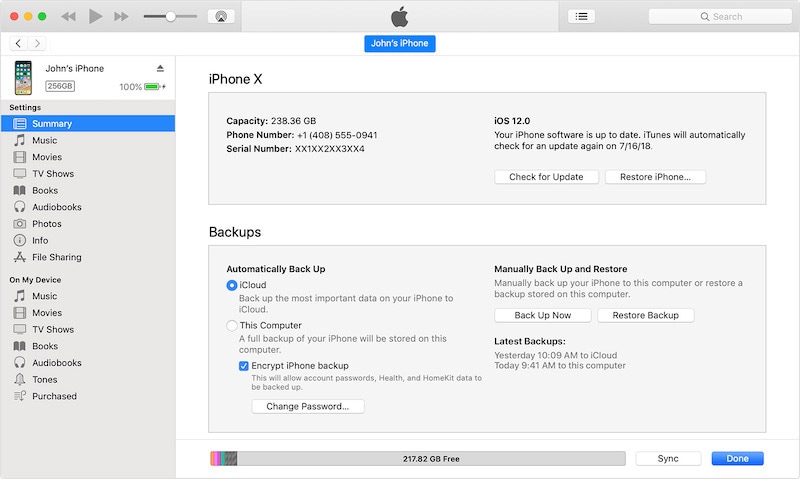
2.4 Restore in recovery mode
In some cases, restoring your device using just iTunes will not be good enough, and it won’t have the effect you’re looking for; in this case, restoring your device with no lock screen after an iOS 17/14 update.
If the above method of restoring your device via iTunes doesn’t work, or you haven’t got a backup file to load, you’ll need to restore your device using a move known as Recovery Mode, or DFU mode. This will hard reset your device and get it working to its full potential.
Here’s how to do it. (Note, the process will differ slightly depending on which model of iPhone you’re using).
Step 1. Press and hold the volume up button for about one second, and then switch and press the Volume Down button for the same amount of time. You can then hold the side button (on devices without a home button), and the following screen should appear after a few seconds.

Step 2. Now connect your Apple iPhone 11 to your computer with iTunes and wait for iTunes to open. Make sure you’re running the latest version of iTunes before connecting up your device. Also, make sure you’re using the official USB cable for the most stability.
Step 3. iTunes should automatically detect that your device is in Recovery Mode and automatically restore your device to a default state without a lock screen. Wait until this process is completed before disconnecting your device and using it as normal.
2.5 Use Find My iPhone feature in iCloud
The fifth and final approach you can take to removing a lock screen from your recently updated iPhone or iPad when faced with the iOS 17/14 glitch is taking advantage of the integrated Apple technology and features are known as Find My iPhone.
While this feature originally allows you to literally find your Apple iPhone 11 in the situation where it’s lost and offers many other security features to help ensure your device and data don’t fall into the wrong hands, you can also use it to remove your device unwanted lock screen.
Of course, this will only work if the Find My iPhone features have been enabled in the past, so make sure you’re using it to get it to work. Here’s how to use the feature to get your phone access back.
Step 1. From your computer, iPad, tablet, or mobile web browser, head over to iCloud.com and log into your iCloud account using the login in button at the top of the screen.

Step 2. Once signed in, scroll down the menu of features and select the Find iPhone feature. Click on the All Devices option at the top.
Step 3. From the list of devices connected to your account, click the Apple iPhone 11 device name with the locked screen and then click the Erase option. This will clear everything from your device, much like the process we’ve spoken about in the methods above.
Leave the Apple iPhone 11 device to erase, and once completed, you’ll be able to pick up and use your phone as normal without a lock screen. You should also now be able to update to iOS 17/14 without any problems!
Summary
And there you go, the five key ways you need to know when it comes to removing an unwanted lock screen from your iOS device after an iOS 17/14 update. We highly recommend the Dr.Fone - Screen Unlock (iOS) since the software makes the whole process incredibly easy, especially when managing any problems you may have on your iOS device!
Also read:
- [Updated] Conquer Color with Pro Techniques in Photography for 2024
- [Updated] Essential Guide to Screen-Recording FaceTime Meetings for 2024
- 2024 Approved Android Video From End to Beginning
- 3 Easy Ways to Factory Reset a Locked Apple iPhone 6s Plus Without iTunes
- 4 Most-Known Ways to Find Someone on Tinder For Infinix Note 30 Pro by Name | Dr.fone
- Creating Captivating Slideshows on the Social Media Giant for 2024
- Different Methods To Unlock Your Apple iPhone SE (2020)
- How to Efficiently Connect and Use Three Computer Displays
- How To Fix Apple iPhone XR Unavailable Issue With Ease
- How To Open Your iPhone 15 Pro Without a Home Button
- In 2024, How To Change Your Apple ID Password On your Apple iPhone SE (2020)
- In 2024, How to Unlock Apple iPhone 12 Pro without Passcode or Face ID
- Resolve Your iPhone 14 Pro Max Keeps Asking for Outlook Password
- Step-by-Step Guide: Moving Your Favorite App From One iPad to the Next
- The way to recover deleted pictures on Tecno without backup.
- WinME Printer No Response - How to Remedy It
- Title: In 2024, How To Fix Auto Lock Greyed Out on iPhone 11
- Author: Sophia
- Created at : 2025-01-05 16:24:52
- Updated at : 2025-01-12 18:08:33
- Link: https://ios-unlock.techidaily.com/in-2024-how-to-fix-auto-lock-greyed-out-on-iphone-11-by-drfone-ios/
- License: This work is licensed under CC BY-NC-SA 4.0.